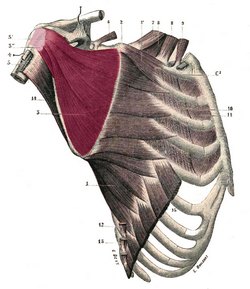The subscapular muscle or subscapularis is a large triangular muscle which is found on the anterior aspect of the scapula, in close relation to the posterolateral aspect of the thorax. It is covered by a well-defined fascia layer, the subscapularis fascia. It is one of the muscles that forms the rotator cuff.
It originates from the internal aspect of the medial border of the scapula, in close proximity to the insertion of the serratus anterior (magnus), and the internal aspect of the inferolateral border of the scapula, where it is separated from the teres major muscle by a thick aponeurosis. It also takes origin directly from the subscapular fossa, where some of the muscular fibers attach directly to the bone.
The muscle inserts by way of a tendon in the lesser tubercle of the humerus and the anterior aspect of the glenohumeral joint capsule. The tendon of the muscle is separated from the neck of the scapula by a large bursa (the infratendinous bursa of the subscapularis) which communicates with the cavity of the glenohumeral joint through an aperture in the capsule.
It receives innervation by two subscapular nerves, both branches of the brachial plexus.
The superior suprascapular nerve arises from the ventral rami of C5 and C6 nerve fibers. It branches from the posterior cord of the brachial plexus and supplies the superior aspect of the muscle. The inferior subscapular nerve arises from the ventral rami of C5 and C6 nerve fibers. It branches from the posterior cord of the brachial plexus and supplies the superior aspect of the muscle. Although these nerves have the same origin from the cervical spine, their origin from the posterior cord of the brachial plexus is different.
This muscle rotates the head of the humerus medially. When the upper extremity is raised, it draws the humerus anteroinferiorly. As part of the shoulder’s rotator cuff it helps prevent subluxation of the glenohumeral joint by keeping the head of the humerus in situ.
The subscapularis is one of the 17 muscles that attach to the scapula.
Note: The image shown in this article is from “Gray’s Anatomy” (1918) which is in the public domain
Sources:
1. “Gray’s Anatomy” Henry Gray, 1918
2. "Tratado de Anatomia Humana" Testut et Latarjet 8th Ed. 1931 Salvat Editores, Spain
3. "Gray's Anatomy" 38th British Ed. Churchill Livingstone 1995
4. “An Illustrated Atlas of the Skeletal Muscles” Bowden, B. 4th Ed. Morton Publishing. 2015
Image modified from the original by Henry VanDyke Carter, MD. Public domain




